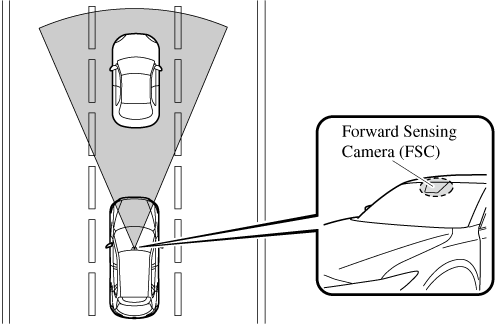

Smart City Brake Support [Forward] (SCBS F) (Some Models)
The SCBS F system alerts the driver of a possible collision using an indication in the display and a warning sound when the Forward Sensing Camera (FSC) detects a vehicle ahead and determines that a collision with a vehicle ahead is unavoidable while the vehicle is being driven at a vehicle speed of about 4 to 80 km/h (2 to 50 mph). In addition, the system reduces damage in the event of a collision by operating the brake control (Smart City Brake Support (SCBS) brake) when the system determines that a collision is unavoidable while the vehicle is being driven at a vehicle speed of about 4 to 30 km/h (2 to 18 mph). It may also be possible to avoid a collision if the relative speed between your vehicle and the vehicle in front of you is less than about 20 km/h (12 mph). In addition, when the driver depresses the brake pedal while the system is in the operation range at about 4 to 30 km/h (2 to 18 mph), the brakes are applied firmly and quickly to assist. (Brake Assist (Smart City Brake Support (SCBS) brake assist))

Do not rely completely on the SCBS F system:
-
The SCBS F system is only designed to reduce damage in the event of a collision. Over reliance on the system leading to the accelerator pedal or brake pedal being mistakenly operated could result in an accident.
-
The SCBS F is a system which operates in response to a vehicle ahead. The system may not be able to detect or react to 2-wheeled vehicles or pedestrians.
In the following cases, turn the system off to prevent a mis-operation:
-
The vehicle is being towed or when towing another vehicle.
-
The vehicle is on a chassis roller.
-
When driving on rough roads such as in areas of dense grass or off-road.
Refer to Stopping the Smart City Brake Support [Forward] (SCBS F) system Operation (Search) on how to turn off the SCBS F system.
-
The SCBS F system will operate under the following conditions.
-
The engine is running.
-
The Smart Brake Support/Smart City Brake Support (SBS/SCBS) system warning indication/warning light (amber) does not illuminate.
-
(Rear-end collision warning)
The vehicle speed is about 4 to 80 km/h (2 to 50 mph).
-
(Brake control (Smart City Brake Support (SCBS) brake))
The vehicle speed is about 4 to 30 km/h (2 to 18 mph).
-
The SCBS F system is not turned off.
-
-
Under the following conditions, the SCBS F system may not operate normally:
-
The SCBS F system will not operate if the driver is deliberately performing driving operations (accelerator pedal and steering wheel).
-
If there is the possibility of partial contact with a vehicle ahead.
-
The vehicle is driven on a slippery road surface such as wet roads or icy or snow-bound roads.
-
The braking performance is adversely affected due to cold temperatures or wet brakes.
-
The vehicle is driven at the same speed as the vehicle ahead.
-
The accelerator pedal is depressed.
-
The brake pedal is depressed.
-
The steering wheel is being operated.
-
The selector lever is being operated.
-
-
In the following cases, the Forward Sensing Camera (FSC) determines that there is a vehicle ahead and the SCBS F may operate.
-
Objects on the road at the entrance to a curve.
-
Vehicles passing in the opposite lane while making a curve.
-
Metal objects, bumps, or protruding objects on the road.
-
When passing through a toll gate.
-
When passing through low gates, narrow gates, car washing machines, or tunnels.
-
If you suddenly come close to a vehicle ahead.
-
2-wheeled vehicles, pedestrians, animals or standing trees.
-
Vehicle is driven with some of the tyres having significant wear.
-
-
(Manual transaxle)
If the vehicle is stopped by the Smart City Brake Support (SCBS) operation and the clutch pedal is not depressed, the engine stops.




